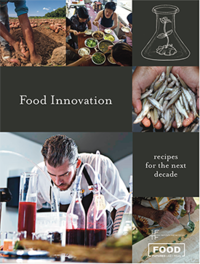Future Now
The IFTF Blog
Delicious Innovation at FoodInno 2017
Arriving at the Stanford design center for the 2017 FoodInno symposium, I was torn between sneaking up to a front row seat for Daniel Patterson’s keynote, sampling a wide selection of coffees with unique stories and provenance, and traveling back in time to enroll in Stanford’s d.school. After a couple espressos and a quick moment to lament that my grad school days are over, I managed to get a decent seat in time for an opening keynote speech that changed the way I view fast food culture. Over the course of the day, there were presentations from the most exciting players in the food scene, refreshingly engaging panels, and plenty of food samples.
When you show up to a Silicon Valley event with a slick website and hashtag ready to go (#foodinno17, for those of you who want to peruse the conversations), you’re primed to expect some glossy techo-aesthetic pizazz. FoodInno, however, struck a nice balance between dazzling its audience with spectacle – self-assembling cannoli, for instance - and speakers who called for social innovation just as much as technological: Preeti Mistry, for one, made sure the conversation touched on how to “reframe food in a way that shows respect and value,” and didn’t pull punches on calling out social injustices in the Bay Area’s restaurant scene.
While I could rave on endlessly about the cool things I saw and ate at FoodInno*, the most exciting part by far was the tacit affirmation that advances in food innovation happen in all forms. Food innovation cannot just be a gold rush to make the next hyped-up app or consumer technology (although it includes some of that, and let’s face it - those things are really fun). When we look at the long-term opportunities for food innovation, we can see an opportunity to grow markets, design meaningful food experiences, improve human health, strengthen communities, and build resilience against climate and market disruption.
Ingredients for Innovation
The IFTF Food Futures Lab’s most recent research release, Food Innovation: Recipes for the Next Decade, explores the landscape for food innovation emerging from the convergence of global shifts in science and technology, agriculture and food systems, and culture and society. It explores forecasts of the ingredients for change in the next decade: capacities, tools, and platforms that innovators will use to transform food experiences from production to shopping to eating. It includes “recipes for food innovation”—pathways forward that strike a balance between science and artistry, constraint and abundance, tradition and invention. These recipes will help you cultivate a shared ethos rooted in openness and participation, inviting unfamiliar actors, from blockchain architects in the cloud to biodesigners with a taste for protein, to join in food system change. Embedded in the report are five futures-thinking exercises to help you find ways to leverage the new ingredients for change and accelerate innovation in your own work and community.
What is good food?
As we explore food innovations that cut across scales and break down barriers between disciplines, it’s important to ask ourselves, for what and for whom are we innovating? What is good food as we look to the future? Michael Frøst of the ever-fascinating Nordic Food Lab put forth a simple heuristic: good food is Nutritious, Delicious, and Meaningful; improving on any one of those aspects is innovation. And that’s part of what makes food such a good medium for shaping the future: it allows for both playful creativity and serious social impact.
Frøst’s formula turned out to be a solid indicator of the forces currently at work in changing the food system, judging by the speakers at FoodInno. Daniel Patterson’s efforts to change the way Americans eat fast food are both pragmatic and staggeringly aspirational, noting that the only good thing about fast food is that “people feel comfortable when they’re eating it.” Lining Yao sees pasta dough as a programmable material just as worthy of scientific study as synthetic polymers or nanostructures, demonstrating that future food design has practical applications like reducing shipping weight. Linguist Daniel Jurafsky reminded us that “innovation happens at the intersections” while sitting on a panel at the intersection of conversation between designer Judy Hsu and chef Jessica Koslow.
Eating for Change
Each of the speakers, producers, organizers, and participants at FoodInno were clear examples of people Eating for Change – influencers using food as their medium for change. As a researcher for IFTF’s Food Futures Lab, I could hardly scribble notes and snap photos quickly enough to take it all in. These people are part of the movements that will be reforming the food system of the next decade—and they aren’t alone. The Food Futures Lab’s research has taken us around the world as we seek out others who are using food as their medium for change. From a farmer cultivating healthy soil and community just outside of Shanghai to a food activist in Oakland, people are using new technologies, social networks, and policy to drive change for their bodies, communities, and the environment. What can these leading-edge people tell us about demands and aspirations for good food in the 21st century?
Join our Food Futures Lab for more!
*Flat-pack pasta that takes on a predetermined form when cooked, Regen Villages that grow their own food and upcycle their waste via black soldier fly larva, discussions on what unites us as eaters, the etymological and historical origins of Ketchup, “Everybody in the industry acknowledges that fish from the ocean are doomed,” Geltor: the first ‘de-extincted’ food, Ava Winery’s 100% synthetic wine, the fully robotic coffee service at CafeX, Smart Food Cities, the Internet of Trust, fresh cacao fruit…follow our Food Futures Lab researchers on Twitter for a near-infinite feed of more exciting innovations and ideas like these.




